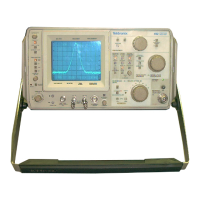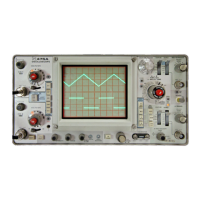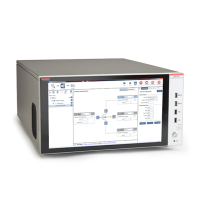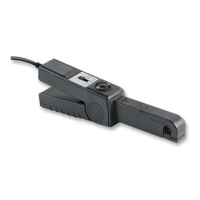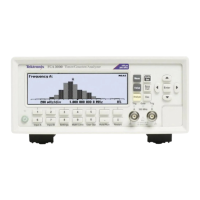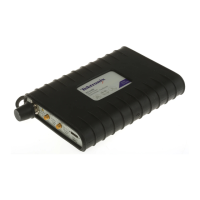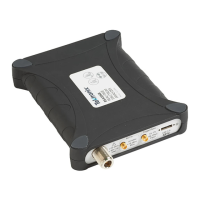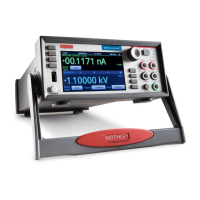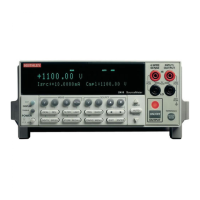Mixer Peaking
As the analyzer sweep rate is increased, the amplitude
of the
CW signal will decrease and the bandwidth becomes
wider; which signifies that both the sensitivity and resolution
have been degraded by the analyzer sweep rate,
The MIXER PEAKING control has a switch and variable
control position and is used to optimize mixer conversion in
the harmonic bands of Band C. The switched position (fully
CCW) is referred to as the SEARCH mode. In this position, an
optimum mixer conversion or sensitivity point is provided
within the dispersion window so signals that are tuned across
The loss of the analyzer sensitivity due to sweep rate
and dispersion can be expressed mathematically as:
where S/S
O
is the ratio of the effective sensitivity to the
the screen will pass through this optimum sensitivity point.
This insures thot most signals within a given dispersion win-
dow will be observed as the RF CENTER FREQUENCY con-
trol is tuned.
analyzer measured sensitivity, at very slow sweep rates or
zero dispersion.
Mixer conversion becomes a manual adjustment with the
control in the VARIABLE position and should be optimized at
each RF CENTER FREQUENCY setting. It has no affect on
band A and is usually broad through the B and C band fre-
D is the dispersion in hertz
B is the -3 dB bandwidth of the analyzer in hertz
T is the sweep time in seconds, or is the sweep rate.
quency range.
Relative amplitude and sensitivity measurements must be
made after the MIXER PEAKING is adjusted because the dis-
play response is not flat when the central is in the SEACH
These same variables also determine the resolution of
the analyzer. The loss in resolution can be expressed as
follows:
position.
Dispersion
Where R/R
O
is the ratio of the effective resolution of the
analyzer to the analyzer measured resolution bandwidth
Dispersion is the swept frequency range, or screen window.
The dispersion is adjustable from 10 MHz/div to 1 kHz/div in
a 1, 2, 5 sequence with an added zero dispersion position
at very slow sweep speeds. R
O
is somewhat arbitrary and
is taken as the displayed width of the CW signal at the
-6 dB point.
for fixed frequency operation. Band A is limited to a maxi-
mum usable dispersion of 5 MHz/div (±25 MHz), because
of the added 235 MHz low pass filter.
The resolution of the Type 491 Spectrum Analyzer is
optimized for most settings of the DISPERSION selector
when the RESOLUTION control is in the coupled position.
Resolution however, can be varied from approximately 100
kHz to less than 1 kHz by uncoupling the RESOLUTION
control and changing it as an independent function of the
DISPERSION selector.
Dispersion accuracy is a function of the IF CENTER FREQ
control position and the DISPERSION RANGE switch set-
ting. See Characteristics section. The dispersion accuracy
far the kHz/div selections is greater than the MHz/div
selections, because the range of the IF CENTER FREQ is ten
times greater for the MHz/div ranges (±25 MHz in the MHz/
DIV range).
The sweep rate, as previously mentioned, should be set
below the sweep rate at which there is no noticeable ampli-
tude loss in the signal.
The front panel DISPERSION-CAL adjustment may be used
to recalibrate dispersion for specific IF CENTER FREQ con-
trol settings if a high degree of accuracy is desired. The pro-
cedure is described in step 4 for front panel calibration.
As previously shown in the above formula the effective
resolution of the analyzer is a function af the IF bandwidth.
To adequately resolve pulsed spectrum information, the reso-
lution bandwidth of the analyzer should be on the order of
1/10 of the sidelobe frequency width or the reciprocal of
the pulse width. The RESOLUTION control is usually set,
after the sweep rate has been adjusted, for optimum main
lobe detail. See Fig. 2-9.
Resolution
Resolution is the ability of the spectrum analyzer to dis-
play adjacent signal frequencies discretely. The measure of
resolution is the frequency separation (in Hz) of two equal
amplitude signals when the notch or dip between these sig-
nals is 3 dB down. The resolution for a given display is a
function of sweep speed, dispersion and bandwidth of the
most selective (usually the last IF) amplifier in the signal path.
Front Panel Calibration Adjustments
Three front panel screwdriver adjustments are provided,
to enable the operator to calibrate the dispersion and IF CEN-
TER FREQ controls, and balance the MHz and kHz positions
of the DISPERSION RANGE selector.
Resolution bandwidth is approximately the -6 dB band-
width (with Gaussian response) of the analyzer, with the dis-
persion and sweep time adjusted for the minimum displayed
bandwidth to a CW signal. Resolution and resolution band-
width become synonymous at very long sweep times.
1. Balance and Calibration Check
As the analyzer sweep rate is increased, the amplitude of
the CW signal will decrease and the bandwidth becomes
wider; which signifies that both the sensitivity and resolution
have been degraded by the analyzer sweep rate.
a. Turn the INT REF FREQ control to OFF position, then
tune a signal on screen with the RF CENTER FREQUENCY
control.
2-10

